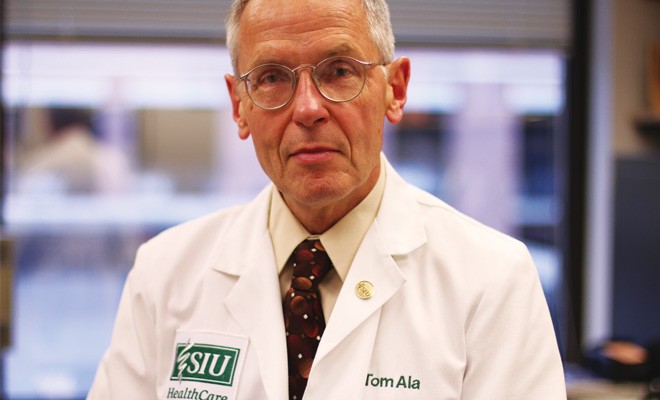
More than 100 years after it was first medically recognized, Alzheimer’s disease still has no cure. It’s not even clear what causes the debilitating and fatal condition, but Alzheimer’s victims in Springfield may have a role to play in changing that.
Southern Illinois University School of Medicine is enrolling Alzheimer’s patients in a national study testing an experimental drug that offers a new approach to a stubborn malady. The school also conducts several other studies aimed at learning how Alzheimer’s starts, how it progresses and how it ultimately affects patients.
Dr. Thomas Ala, interim director of the Center for Alzheimer’s Disease and Related Disorders (CADRD) at SIU School of Medicine, was working as a chemical engineer for 3M before he decided to become a neurologist. His decision came after seeing people he cared about diagnosed with degenerative diseases like multiple sclerosis and muscular dystrophy.
“I’m interested in wiring diagrams and logical things, so neurology was a natural fit because it’s basically wiring diagrams of the brain,” Ala said. “Nobody was helping them. It was like the light went on, and I thought, ‘I’ve got to try to help.’ ”
Ala joined SIU in 1999 and was appointed director of CADRD in 2007. He says the lack of a cure or even an understanding of the cause of Alzheimer’s disease can be discouraging. There hasn’t even been a new drug approved by the federal Food and Drug Administration since 2003 – more than 10 years ago.
“It’s really frustrating because we have to deal with patients and their caregivers or spouses,” Ala said. “They come in and say ‘How can you help us?’ and we have to tell them that the drugs we have don’t stop or slow the disease. It’s only going to get worse. Plan for the nursing home. This can be a real downer, so we try to help them any way we can.”
Ala explains that Alzheimer’s disease involves the death of millions of brain cells, leaving the brain unable to function properly. Examination of the brains of Alzheimer’s patients always shows the presence of two mysterious proteins: beta amyloids and tau proteins. Most previous research assumed that the beta amyloids were the cause of Alzheimer’s because their presence in the brain seems to be linked to a genetic defect, Ala said. Attempts to cure the disease often focus on preventing the accumulation of those beta amyloids, but that approach has proved mostly fruitless, failing to yield a cure or even a means to reliably slow the progression of Alzheimer’s.
The newest study undertaken by Ala and his team is organized by Toyama Chemical Company in Japan. SIU School of Medicine is one of about 100 sites around the U.S. at which Alzheimer’s patients will take a drug known as T-817MA. It works by preventing the formation of beta amyloids and tau proteins, while also promoting the growth of neurons in the brain.
About one-third of the expected 450 patients nationwide will be given a placebo. During the trial period, patients will undergo regular tests of their cognitive and physical abilities, along with blood tests and an MRI scan at the beginning and end of the study. Ala expects to enroll between 5 and 10 patients in Springfield to participate.
The study of T-817MA was approved by the school’s institutional review board to ensure ethics guidelines are followed, Ala says – a standard practice in any medicinal or behavioral study involving humans. SIU also has five other Alzheimer’s studies already under way.
Tina Arnold of Springfield, who serves as senior manager of special events for the Illinois Chapter of the Alzheimer’s Association, says every case of Alzheimer’s is different, but patients often exhibit short-term memory loss, difficulty with planning or solving problems, and other symptoms. Alzheimer’s is fatal because it destroys parts of the brain responsible for regulating involuntary processes like heartbeat and swallowing.
“It doesn’t stop at the forgetting,” she said. “It continues to move through the brain and kill nerve cells. It really is devastating.”
Arnold says her organization offers support for both patients and their caregivers.
“It’s a 24-7 job taking care of someone with Alzheimer’s, and it doesn’t stop,” Arnold said. “You don’t know what tomorrow’s going to bring. It’s definitely taxing on the caregiver, especially when the person is to the point of not realizing that they’re making these mistakes, that they’re forgetting, that they’re changing. The caregiver really takes the brunt of it then.”
Contact Patrick Yeagle at [email protected].
For more information, contact:
Barbara Cray Lokaitis, BA, CCRP
Center for Clinical Research
SIU School of Medicine
Springfield, IL
217.545.9737
[email protected]



















